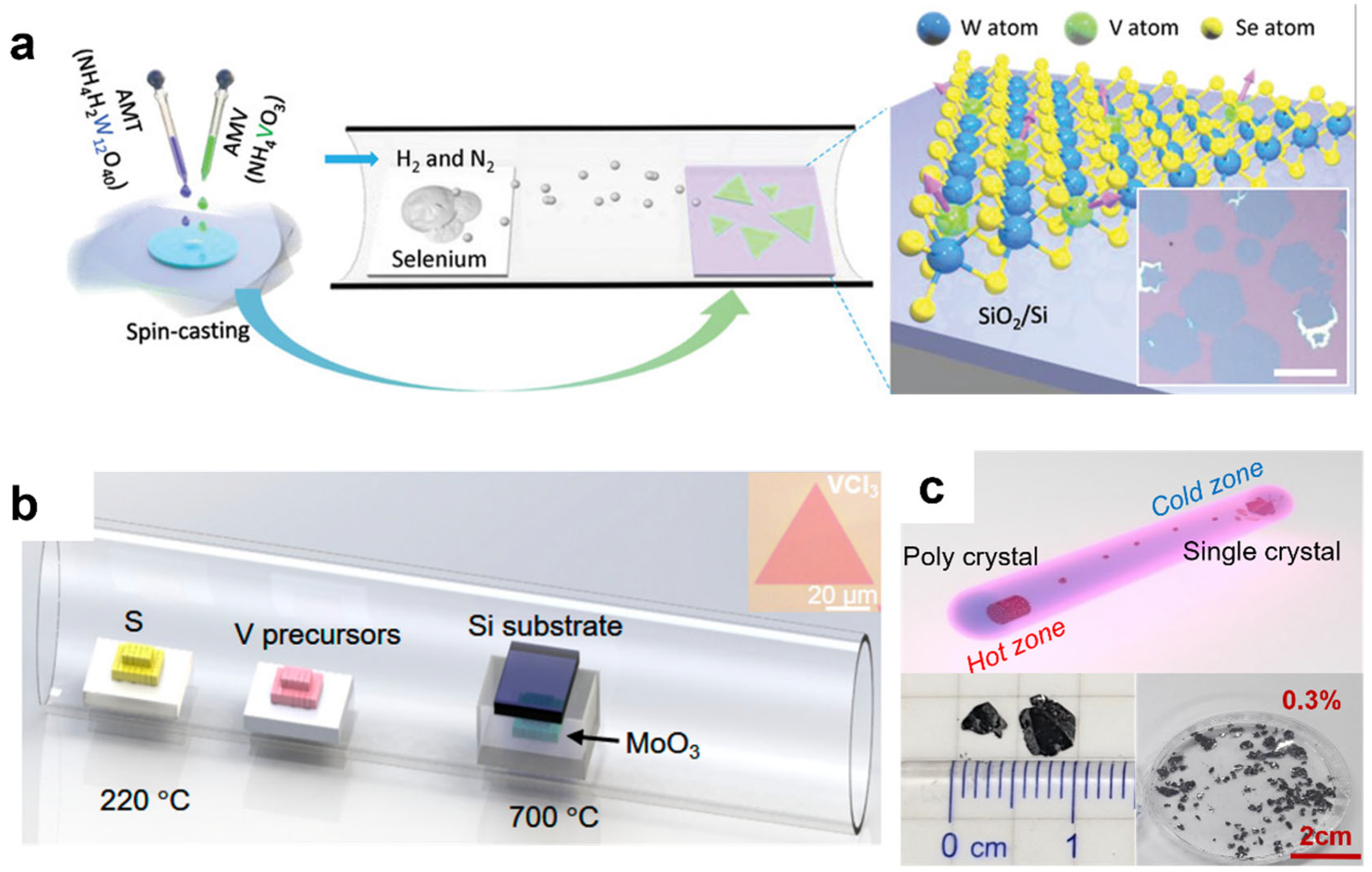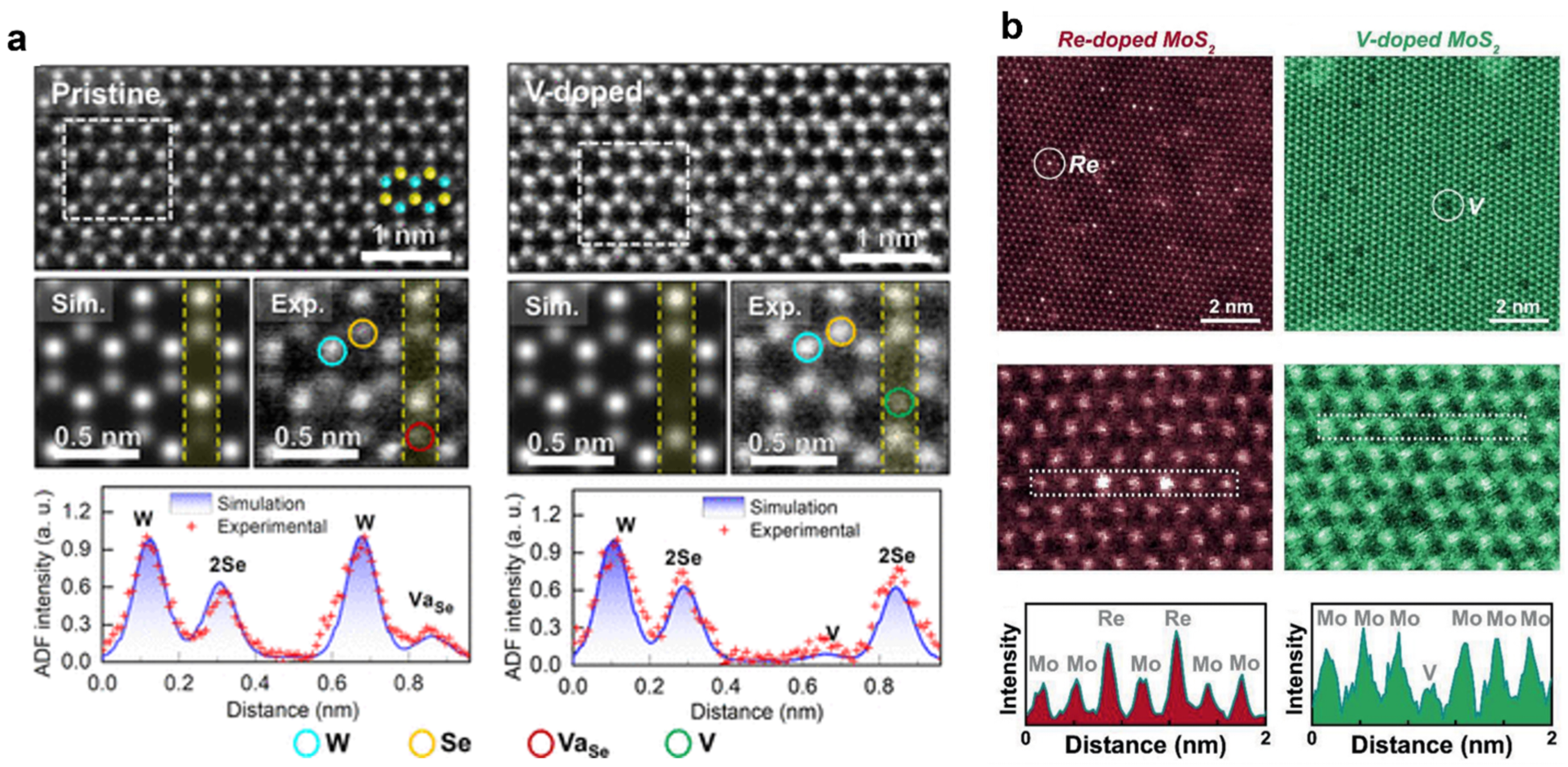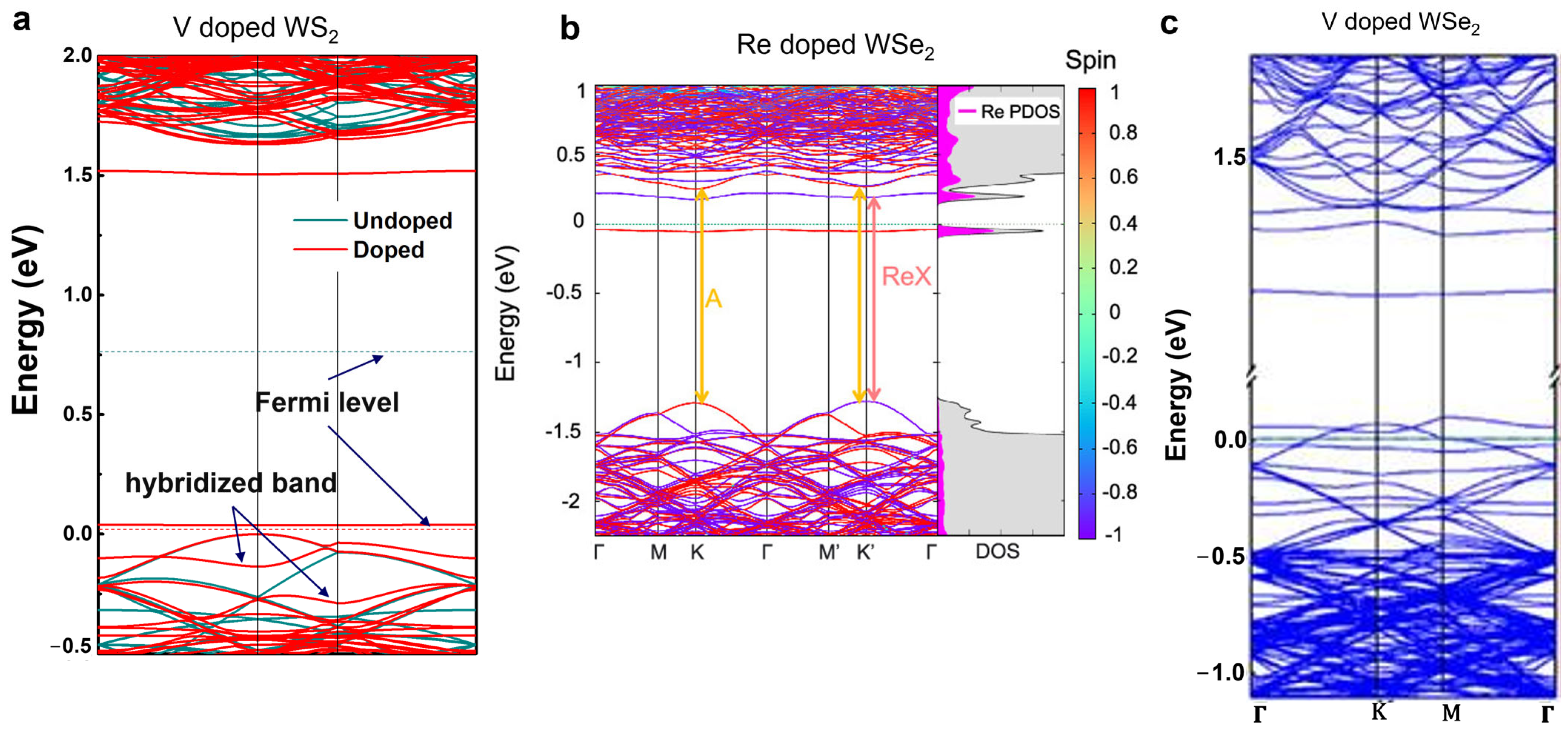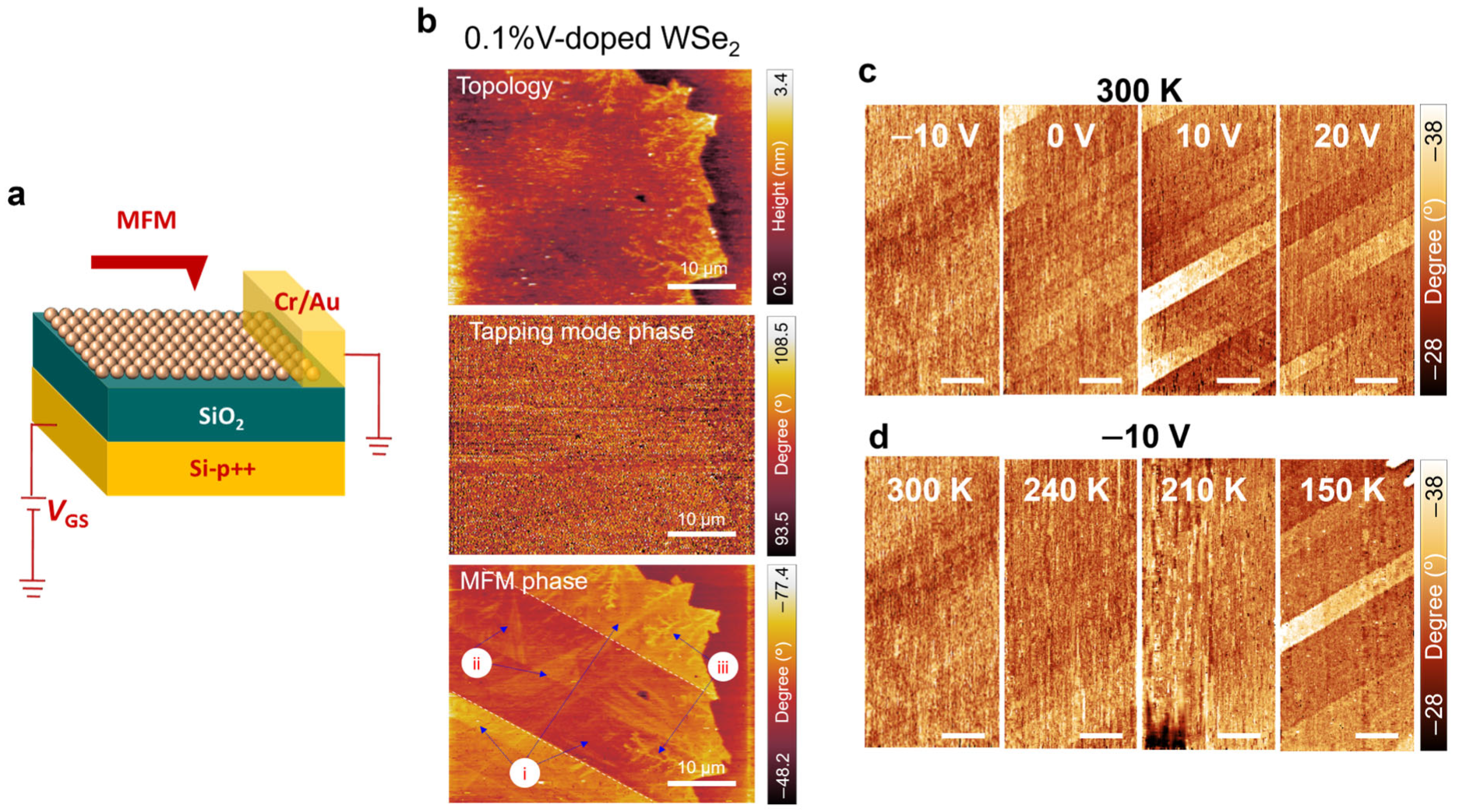Doped, Two-Dimensional, Semiconducting Transition Metal Dichalcogenides in Low-Concentration Regime
Abstract
1. Introduction
2. Growth Approaches for Doped TMDCs
2.1. Structural Properties
2.2. Electronic Transport Properties of p- and n-Type Doped TMDCs
2.3. Magnetic Properties of Doped TMDCs
3. Dopant Distributions in TMDCs
4. V-Doped WSe2 Grown by Using CVT Method
4.1. Selection of Ampule and Cleaning
4.2. Step 1: Weighing, Mixing Powders, Vacuum Sealing, and Solid-State Reaction
4.3. Step 2: Single Crystal Growth
4.4. Extraction of Crystals from Ampoules and Removing Transport Agent
5. Challenges and Opportunities with Doped TMDCs
5.1. Searching for Universal n- and p-Type Dopants
5.2. Uniformity Controls the Dopant Distributions
5.3. Understanding the Mechanism of Long-Range Magnetic Order in Magnetic, Doped TMDs
5.4. Designing Different Doping Types for Diverse Applications
6. Conclusions
Author Contributions
Funding
Data Availability Statement
Conflicts of Interest
References
- Geim, A.K.; Grigorieva, I.V. Van Der Waals Heterostructures. Nature 2013, 499, 419–425. [Google Scholar] [CrossRef] [PubMed]
- Akinwande, D.; Huyghebaert, C.; Wang, C.H.; Serna, M.I.; Goossens, S.; Li, L.J.; Wong, H.S.P.; Koppens, F.H.L. Graphene and Two-Dimensional Materials for Silicon Technology. Nature 2019, 573, 507–518. [Google Scholar] [CrossRef]
- Cao, W.; Bu, H.; Vinet, M.; Cao, M.; Takagi, S.; Hwang, S.; Ghani, T.; Banerjee, K. The Future Transistors. Nature 2023, 620, 501–515. [Google Scholar] [CrossRef]
- Manzeli, S.; Ovchinnikov, D.; Pasquier, D.; Yazyev, O.V.; Kis, A. 2D Transition Metal Dichalcogenides. Nat. Rev. Mater. 2017, 2, 17033. [Google Scholar] [CrossRef]
- Montblanch, A.R.P.; Barbone, M.; Aharonovich, I.; Atatüre, M.; Ferrari, A.C. Layered Materials as a Platform for Quantum Technologies. Nat. Nanotechnol. 2023, 18, 555–571. [Google Scholar] [CrossRef] [PubMed]
- Yu, S.; Wu, X.; Wang, Y.; Guo, X.; Tong, L. 2D Materials for Optical Modulation: Challenges and Opportunities. Adv. Mater. 2017, 29, 1606128. [Google Scholar] [CrossRef] [PubMed]
- Ugeda, M.M.; Bradley, A.J.; Shi, S.-F.; da Jornada, F.H.; Zhang, Y.; Qiu, D.Y.; Ruan, W.; Mo, S.-K.; Hussain, Z.; Shen, Z.-X.; et al. Giant Bandgap Renormalization and Excitonic Effects in a Monolayer Transition Metal Dichalcogenide Semiconductor. Nat. Mater. 2014, 13, 1091–1095. [Google Scholar] [CrossRef] [PubMed]
- Mak, K.F.; Shan, J. Photonics and Optoelectronics of 2D Semiconductor Transition Metal Dichalcogenides. Nat. Photonics 2016, 10, 216–226. [Google Scholar] [CrossRef]
- Das, S.; Gupta, G.; Majumdar, K. Layer Degree of Freedom for Excitons in Transition Metal Dichalcogenides. Phys. Rev. B 2019, 99, 165411. [Google Scholar] [CrossRef]
- Qiu, D.Y.; da Jornada, F.H.; Louie, S.G. Optical Spectrum of MoS2: Many-Body Effects and Diversity of Exciton States. Phys. Rev. Lett. 2013, 111, 216805. [Google Scholar] [CrossRef]
- Mueller, T.; Malic, E. Exciton Physics and Device Application of Two-Dimensional Transition Metal Dichalcogenide Semiconductors. npj 2D Mater. Appl. 2018, 2, 29. [Google Scholar] [CrossRef]
- Kogar, A.; Rak, M.S.; Vig, S.; Husain, A.A.; Flicker, F.; Joe, Y.I.; Venema, L.; MacDougall, G.J.; Chiang, T.C.; Fradkin, E.; et al. Signatures of Exciton Condensation in a Transition Metal Dichalcogenide. Science 2017, 358, 1314–1317. [Google Scholar] [CrossRef] [PubMed]
- Debnath, B.; Barlas, Y.; Wickramaratne, D.; Neupane, M.R.; Lake, R.K. Exciton Condensate in Bilayer Transition Metal Dichalcogenides: Strong Coupling Regime. Phys. Rev. B 2017, 96, 174504. [Google Scholar] [CrossRef]
- Nimbalkar, A.; Kim, H. Opportunities and Challenges in Twisted Bilayer Graphene: A Review. Nano-Micro Lett. 2020, 12, 126. [Google Scholar] [CrossRef]
- Zhang, Y.; Zhan, Z.; Guinea, F.; Silva-Guillen, J.A.; Yuan, S. Tuning Band Gaps in Twisted Bilayer MoS2. Phys. Rev. B 2020, 102, 235418. [Google Scholar] [CrossRef]
- Andrei, E.Y.; Efetov, D.K.; Jarillo-Herrero, P.; MacDonald, A.H.; Mak, K.F.; Senthil, T.; Tutuc, E.; Yazdani, A.; Young, A.F. The Marvels of Moiré Materials. Nat. Rev. Mater. 2021, 6, 201–206. [Google Scholar] [CrossRef]
- Mak, K.F.; Shan, J. Semiconductor Moiré Materials. Nat. Nanotechnol. 2022, 17, 686–695. [Google Scholar] [CrossRef]
- Devakul, T.; Crépel, V.; Zhang, Y.; Fu, L. Magic in Twisted Transition Metal Dichalcogenide Bilayers. Nat. Commun. 2021, 12, 6730. [Google Scholar] [CrossRef] [PubMed]
- Yankowitz, M.; Mak, K.F. Moiré Coupling and Other Emergent Phenomena in Stacked van Der Waals Materials. APL Mater. 2022, 10, 080401. [Google Scholar] [CrossRef]
- Behura, S.K.; Miranda, A.; Nayak, S.; Johnson, K.; Das, P.; Pradhan, N.R. Moiré Physics in Twisted van Der Waals Heterostructures of 2D Materials. Emergent Mater. 2021, 4, 813–826. [Google Scholar] [CrossRef]
- Zhao, W.; Shen, B.; Tao, Z.; Han, Z.; Kang, K.; Watanabe, K.; Taniguchi, T.; Mak, K.F.; Shan, J. Gate-Tunable Heavy Fermions in a Moiré Kondo Lattice. Nature 2023, 616, 61–65. [Google Scholar] [CrossRef] [PubMed]
- Tang, Y.; Su, K.; Li, L.; Xu, Y.; Liu, S.; Watanabe, K.; Taniguchi, T.; Hone, J.; Jian, C.-M.; Xu, C.; et al. Evidence of Frustrated Magnetic Interactions in a Wigner–Mott Insulator. Nat. Nanotechnol. 2023, 18, 233–237. [Google Scholar] [CrossRef] [PubMed]
- Kang, K.; Shen, B.; Qiu, Y.; Zeng, Y.; Xia, Z.; Watanabe, K.; Taniguchi, T.; Shan, J.; Mak, K.F. Evidence of the Fractional Quantum Spin Hall Effect in Moiré MoTe2. Nature 2024, 628, 522–526. [Google Scholar] [CrossRef]
- Ju, L.; MacDonald, A.H.; Mak, K.F.; Shan, J.; Xu, X. The Fractional Quantum Anomalous Hall Effect. Nat. Rev. Mater. 2024, 9, 455–459. [Google Scholar] [CrossRef]
- Padhi, B.; Chitra, R.; Phillips, P.W. Generalized Wigner Crystallization in Moiré Materials. Phys. Rev. B 2021, 103, 125146. [Google Scholar] [CrossRef]
- Dolui, K.; Rungger, I.; Das Pemmaraju, C.; Sanvito, S. Possible Doping Strategies for MoS2 Monolayers: An Ab Initio Study. Phys. Rev. B 2013, 88, 075420. [Google Scholar] [CrossRef]
- Suh, J.; Park, T.E.; Lin, D.Y.; Fu, D.; Park, J.; Jung, H.J.; Chen, Y.; Ko, C.; Jang, C.; Sun, Y.; et al. Doping against the Native Propensity of MoS2: Degenerate Hole Doping by Cation Substitution. Nano Lett. 2014, 14, 6976–6982. [Google Scholar] [CrossRef]
- Mukherjee, R.; Chuang, H.J.; Koehler, M.R.; Combs, N.; Patchen, A.; Zhou, Z.X.; Mandrus, D. Substitutional Electron and Hole Doping of WSe2: Synthesis, Electrical Characterization, and Observation of Band-to-Band Tunneling. Phys. Rev. Appl. 2017, 7, 034011. [Google Scholar] [CrossRef]
- Pandey, S.K.; Alsalman, H.; Azadani, J.G.; Izquierdo, N.; Low, T.; Campbell, S.A. Controlled p-Type Substitutional Doping in Large-Area Monolayer WSe2 Crystals Grown by Chemical Vapor Deposition. Nanoscale 2018, 10, 21374–21385. [Google Scholar] [CrossRef]
- Chowdhury, S.; Venkateswaran, P.; Somvanshi, D. A Systematic Study on the Electronic Structure of 3d, 4d, and 5d Transition Metal-Doped WSe2 Monolayer. Superlattices Microstruct. 2020, 148, 106746. [Google Scholar] [CrossRef]
- Gao, H.; Suh, J.; Cao, M.C.; Joe, A.Y.; Mujid, F.; Lee, K.-H.H.; Xie, S.; Xie, S.; Lee, J.-U.U.; Kang, K.; et al. Tuning Electrical Conductance of MoS2 Monolayers through Substitutional Doping. Nano Lett. 2020, 20, 4095–4101. [Google Scholar] [CrossRef] [PubMed]
- Li, M.; Yao, J.; Wu, X.; Zhang, S.; Xing, B.; Niu, X.; Yan, X.; Yu, Y.; Liu, Y.; Wang, Y. p-Type Doping in Large-Area Monolayer MoS2 by Chemical Vapor Deposition. ACS Appl. Mater. Interfaces 2020, 12, 6276–6282. [Google Scholar] [CrossRef] [PubMed]
- Jeong, J.H.; Kang, S.; Kim, N.; Joshi, R.; Lee, G.H. Recent Trends in Covalent Functionalization of 2D Materials. Phys. Chem. Chem. Phys. 2022, 24, 10684–10711. [Google Scholar] [CrossRef]
- Lin, Y.C.; Torsi, R.; Geohegan, D.B.; Robinson, J.A.; Xiao, K. Controllable Thin-Film Approaches for Doping and Alloying Transition Metal Dichalcogenides Monolayers. Adv. Sci. 2021, 8, 2004249. [Google Scholar] [CrossRef] [PubMed]
- Komsa, H.P.; Krasheninnikov, A.V. Two-Dimensional Transition Metal Dichalcogenide Alloys: Stability and Electronic Properties. J. Phys. Chem. Lett. 2012, 3, 3652–3656. [Google Scholar] [CrossRef]
- Yun, S.J.; Duong, D.L.; Ha, D.M.; Singh, K.; Phan, T.L.; Choi, W.; Kim, Y.M.; Lee, Y.H. Ferromagnetic Order at Room Temperature in Monolayer WSe2 Semiconductor via Vanadium Dopant. Adv. Sci. 2020, 7, 1903076. [Google Scholar] [CrossRef]
- Song, B.; Yun, S.J.; Jiang, J.; Avila, J.; Beach, K.; Choi, W.; Kim, Y.-M.M.; Yoon, D.; Terrones, H.; Song, Y.J.; et al. Evidence of Itinerant Holes for Long-Range Magnetic Order in the Tungsten Diselenide Semiconductor with Vanadium Dopants. Phys. Rev. B 2021, 103, 094432. [Google Scholar] [CrossRef]
- Jiang, J.; Nguyen, L.A.T.; Nguyen, T.D.; Luong, D.H.; Kim, D.Y.; Jin, Y.; Kim, P.; Duong, D.L.; Lee, Y.H. Probing Giant Zeeman Shift in Vanadium-Doped WSe2 via Resonant Magnetotunneling Transport. Phys. Rev. B 2021, 103, 014441. [Google Scholar] [CrossRef]
- Qin, Z.; Loh, L.; Wang, J.; Xu, X.; Zhang, Q.; Haas, B.; Alvarez, C.; Okuno, H.; Yong, J.Z.; Schultz, T.; et al. Growth of Nb-Doped Monolayer WS2 by Liquid-Phase Precursor Mixing. ACS Nano 2019, 13, 10768–10775. [Google Scholar] [CrossRef]
- Fu, Y.; Long, M.; Gao, A.; Wang, Y.; Pan, C.; Liu, X.; Zeng, J.; Xu, K.; Zhang, L.; Liu, E.; et al. Intrinsic p-Type W-Based Transition Metal Dichalcogenide by Substitutional Ta-Doping. Appl. Phys. Lett. 2017, 111, 043502. [Google Scholar] [CrossRef]
- Li, S.; Hong, J.; Gao, B.; Lin, Y.; Lim, H.E.; Lu, X.; Wu, J.; Liu, S.; Tateyama, Y.; Sakuma, Y.; et al. Tunable Doping of Rhenium and Vanadium into Transition Metal Dichalcogenides for Two-Dimensional Electronics. Adv. Sci. 2021, 8, 2004438. [Google Scholar] [CrossRef]
- Ortiz Jimenez, V.; Pham, Y.T.H.; Liu, M.; Zhang, F.; Yu, Z.; Kalappattil, V.; Muchharla, B.; Eggers, T.; Duong, D.L.; Terrones, M.; et al. Light-Controlled Room Temperature Ferromagnetism in Vanadium-Doped Tungsten Disulfide Semiconducting Monolayers. Adv. Electron. Mater. 2021, 7, 2100030. [Google Scholar] [CrossRef]
- Zou, J.; Cai, Z.; Lai, Y.; Tan, J.; Zhang, R.; Feng, S.; Wang, G.; Lin, J.; Liu, B.; Cheng, H.M. Doping Concentration Modulation in Vanadium-Doped Monolayer Molybdenum Disulfide for Synaptic Transistors. ACS Nano 2021, 15, 7340–7347. [Google Scholar] [CrossRef] [PubMed]
- Hu, S.Y.; Cheng, M.C.; Tiong, K.K.; Huang, Y.S. The Electrical and Optical Anisotropy of Rhenium-Doped WSe2 Single Crystals. J. Phys. Condens. Matter 2005, 17, 3575–3583. [Google Scholar] [CrossRef]
- Kozhakhmetov, A.; Schuler, B.; Tan, A.M.Z.; Cochrane, K.A.; Nasr, J.R.; El-Sherif, H.; Bansal, A.; Vera, A.; Bojan, V.; Redwing, J.M.; et al. Scalable Substitutional Re-Doping and Its Impact on the Optical and Electronic Properties of Tungsten Diselenide. Adv. Mater. 2020, 32, 2005159. [Google Scholar] [CrossRef]
- Loh, L.; Zhang, Z.; Bosman, M.; Eda, G. Substitutional Doping in 2D Transition Metal Dichalcogenides. Nano Res. 2021, 14, 1668–1681. [Google Scholar] [CrossRef]
- Duong, D.L.; Kim, S.G.; Lee, Y.H. Gate Modulation of the Long-Range Magnetic Order in a Vanadium-Doped WSe2 semiconductor. AIP Adv. 2020, 10, 065220. [Google Scholar] [CrossRef]
- Tiwari, S.; Van de Put, M.; Sorée, B.; Hinkle, C.; Vandenberghe, W.G. Reduction of Magnetic Interaction Due to Clustering in Doped Transition-Metal Dichalcogenides: A Case Study of Mn-, V-, and Fe-Doped WSe2. ACS Appl. Mater. Interfaces 2024, 16, 4991–4998. [Google Scholar] [CrossRef] [PubMed]
- Martinez, L.M.; Delgado, J.A.; Saiz, C.L.; Cosio, A.; Wu, Y.; Villagrán, D.; Gandha, K.; Karthik, C.; Nlebedim, I.C.; Singamaneni, S.R. Magnetic and Electrocatalytic Properties of Transition Metal Doped MoS2 Nanocrystals. J. Appl. Phys. 2018, 124, 153903. [Google Scholar] [CrossRef]
- Nguyen, L.-A.T.; Dhakal, K.P.; Lee, Y.; Choi, W.; Nguyen, T.D.; Hong, C.; Luong, D.H.; Kim, Y.-M.; Kim, J.; Lee, M.; et al. Spin-Selective Hole–Exciton Coupling in a V-Doped WSe2 Ferromagnetic Semiconductor at Room Temperature. ACS Nano 2021, 15, 20267–20277. [Google Scholar] [CrossRef]
- Duong, D.L.; Yun, S.J.; Kim, Y.; Kim, S.-G.G.; Lee, Y.H. Long-Range Ferromagnetic Ordering in Vanadium-Doped WSe2 Semiconductor. Appl. Phys. Lett. 2019, 115, 242406. [Google Scholar] [CrossRef]
- Xu, H.; Xu, S.; Xu, X.; Zhuang, J.; Hao, W.; Du, Y. Recent Advances in Two-Dimensional van Der Waals Magnets. Microstructures 2022, 2, 2022011. [Google Scholar] [CrossRef]
- Tang, L.; Tan, J.; Nong, H.; Liu, B.; Cheng, H.M. Chemical Vapor Deposition Growth of Two-Dimensional Compound Materials: Controllability, Material Quality, and Growth Mechanism. Acc. Mater. Res. 2021, 2, 36–47. [Google Scholar] [CrossRef]
- Eichfeld, S.M.; Hossain, L.; Lin, Y.-C.; Piasecki, A.F.; Kupp, B.; Birdwell, A.G.; Burke, R.A.; Lu, N.; Peng, X.; Li, J.; et al. Highly Scalable, Atomically Thin WSe2 Grown via Metal–Organic Chemical Vapor Deposition. ACS Nano 2015, 9, 2080–2087. [Google Scholar] [CrossRef] [PubMed]
- Kang, K.; Xie, S.; Huang, L.; Han, Y.; Huang, P.Y.; Mak, K.F.; Kim, C.-J.; Muller, D.; Park, J. High-Mobility Three-Atom-Thick Semiconducting Films with Wafer-Scale Homogeneity. Nature 2015, 520, 656–660. [Google Scholar] [CrossRef] [PubMed]
- Nakano, M.; Wang, Y.; Kashiwabara, Y.; Matsuoka, H.; Iwasa, Y. Layer-by-Layer Epitaxial Growth of Scalable WSe2 on Sapphire by Molecular Beam Epitaxy. Nano Lett. 2017, 17, 5595–5599. [Google Scholar] [CrossRef]
- Peng, J.-P.; Guan, J.-Q.; Zhang, H.-M.; Song, C.-L.; Wang, L.; He, K.; Xue, Q.-K.; Ma, X.-C. Molecular Beam Epitaxy Growth and Scanning Tunneling Microscopy Study of TiSe2 Ultrathin Films. Phys. Rev. B 2015, 91, 121113. [Google Scholar] [CrossRef]
- Poh, S.M.; Zhao, X.; Tan, S.J.R.; Fu, D.; Fei, W.; Chu, L.; Jiadong, D.; Zhou, W.; Pennycook, S.J.; Castro Neto, A.H.; et al. Molecular Beam Epitaxy of Highly Crystalline MoSe2 on Hexagonal Boron Nitride. ACS Nano 2018, 12, 7562–7570. [Google Scholar] [CrossRef]
- Chen, M.-W.; Ovchinnikov, D.; Lazar, S.; Pizzochero, M.; Whitwick, M.B.; Surrente, A.; Baranowski, M.; Sanchez, O.L.; Gillet, P.; Plochocka, P.; et al. Highly Oriented Atomically Thin Ambipolar MoSe2 Grown by Molecular Beam Epitaxy. ACS Nano 2017, 11, 6355–6361. [Google Scholar] [CrossRef] [PubMed]
- Legma, J.B.; Vacquier, G.; Casalot, A. Chemical Vapour Transport of Molybdenum and Tungsten Diselenides by Various Transport Agents. J. Cryst. Growth 1993, 130, 253–258. [Google Scholar] [CrossRef]
- Hu, D.; Xu, G.; Xing, L.; Yan, X.; Wang, J.; Zheng, J.; Lu, Z.; Wang, P.; Pan, X.; Jiao, L. Two-Dimensional Semiconductors Grown by Chemical Vapor Transport. Angew. Chem. 2017, 129, 3665–3669. [Google Scholar] [CrossRef]
- Binnewies, M.; Glaum, R.; Schmidt, M.; Schmidt, P. Chemical Vapor Transport Reactions; DE GRUYTER: Berlin, Germany, 2012. [Google Scholar]
- May, A.F.; Yan, J.; McGuire, M.A. A Practical Guide for Crystal Growth of van Der Waals Layered Materials. J. Appl. Phys. 2020, 128, 051101. [Google Scholar] [CrossRef]
- Canfield, P.C.; Fisher, I.R. High-Temperature Solution Growth of Intermetallic Single Crystals and Quasicrystals. J. Cryst. Growth 2001, 225, 155–161. [Google Scholar] [CrossRef]
- Rhodes, D.A.; Jindal, A.; Yuan, N.F.Q.; Jung, Y.; Antony, A.; Wang, H.; Kim, B.; Chiu, Y.; Taniguchi, T.; Watanabe, K.; et al. Enhanced Superconductivity in Monolayer Td -MoTe2. Nano Lett. 2021, 21, 2505–2511. [Google Scholar] [CrossRef]
- Keum, D.H.; Cho, S.; Kim, J.H.; Choe, D.-H.; Sung, H.-J.; Kan, M.; Kang, H.; Hwang, J.-Y.; Kim, S.W.; Yang, H.; et al. Bandgap Opening in Few-Layered Monoclinic MoTe2. Nat. Phys. 2015, 11, 482–486. [Google Scholar] [CrossRef]
- Schmidt, P.; Binnewies, M.; Glaum, R.; Schmidt, M. Chemical Vapor Transport Reactions–Methods, Materials, Modeling. In Advanced Topics on Crystal Growth; InTech: London, UK, 2013. [Google Scholar]
- Pisoni, A.; Jacimovic, J.; Barišic, O.S.; Walter, A.; Náfrádi, B.; Bugnon, P.; Magrez, A.; Berger, H.; Revay, Z.; Forrö, L. The Role of Transport Agents in MoS2 Single Crystals. J. Phys. Chem. C 2015, 119, 3918–3922. [Google Scholar] [CrossRef]
- Upadhyayula, L.C.; Loferski, J.J.; Wold, A.; Giriat, W.; Kershaw, R. Semiconducting Properties of Single Crystals of n- and p-Type Tungsten Diselenide (WSe2). J. Appl. Phys. 1968, 39, 4736–4740. [Google Scholar] [CrossRef]
- Agarwal, M.K.; Nagi Reddy, K.; Patel, H.B. Growth of Tungstenite Single Crystals by Direct Vapour Transport Method. J. Cryst. Growth 1979, 46, 139–142. [Google Scholar] [CrossRef]
- Loh, L.; Chen, Y.; Wang, J.; Yin, X.; Tang, C.S.; Zhang, Q.; Watanabe, K.; Taniguchi, T.; Wee, A.T.S.; Bosman, M.; et al. Impurity-Induced Emission in Re-Doped WS2 Monolayers. Nano Lett. 2021, 21, 5293–5300. [Google Scholar] [CrossRef]
- Iqbal, M.W.; Elahi, E.; Amin, A.; Hussain, G.; Aftab, S. Chemical Doping of Transition Metal Dichalcogenides (TMDCs) Based Field Effect Transistors: A Review. Superlattices Microstruct. 2020, 137, 106350. [Google Scholar] [CrossRef]
- Ang, Y.S.; Yang, H.Y.; Ang, L.K. Universal Scaling Laws in Schottky Heterostructures Based on Two-Dimensional Materials. Phys. Rev. Lett. 2018, 121, 056802. [Google Scholar] [CrossRef] [PubMed]
- Tersoff, J. Schottky Barrier Heights and the Continuum of Gap States. Phys. Rev. Lett. 1984, 52, 465–468. [Google Scholar] [CrossRef]
- Shen, P.-C.; Su, C.; Lin, Y.; Chou, A.-S.; Cheng, C.-C.; Park, J.-H.; Chiu, M.-H.; Lu, A.-Y.; Tang, H.-L.; Tavakoli, M.M.; et al. Ultralow Contact Resistance between Semimetal and Monolayer Semiconductors. Nature 2021, 593, 211–217. [Google Scholar] [CrossRef]
- Wang, Y.; Kim, J.C.; Wu, R.J.; Martinez, J.; Song, X.; Yang, J.; Zhao, F.; Mkhoyan, A.; Jeong, H.Y.; Chhowalla, M. Van Der Waals Contacts between Three-Dimensional Metals and Two-Dimensional Semiconductors. Nature 2019, 568, 70–74. [Google Scholar] [CrossRef]
- Wang, Y.; Kim, J.C.; Li, Y.; Ma, K.Y.; Hong, S.; Kim, M.; Shin, H.S.; Jeong, H.Y.; Chhowalla, M. P-Type Electrical Contacts for 2D Transition-Metal Dichalcogenides. Nature 2022, 610, 61–66. [Google Scholar] [CrossRef] [PubMed]
- Zheng, Y.; Gao, J.; Han, C.; Chen, W. Ohmic Contact Engineering for Two-Dimensional Materials. Cell Rep. Phys. Sci. 2021, 2, 100298. [Google Scholar] [CrossRef]
- Allain, A.; Kang, J.; Banerjee, K.; Kis, A. Electrical Contacts to Two-Dimensional Semiconductors. Nat. Mater. 2015, 14, 1195–1205. [Google Scholar] [CrossRef]
- Xie, J.; Zhang, Z.; Zhang, H.; Nagarajan, V.; Zhao, W.; Kim, H.L.; Sanborn, C.; Qi, R.; Chen, S.; Kahn, S.; et al. Low Resistance Contact to P-Type Monolayer WSe2. Nano Lett. 2024, 24, 5937–5943. [Google Scholar] [CrossRef]
- Pack, J.; Guo, Y.; Liu, Z.; Jessen, B.S.; Holtzman, L.; Liu, S.; Cothrine, M.; Watanabe, K.; Taniguchi, T.; Mandrus, D.G.; et al. Charge-Transfer Contacts for the Measurement of Correlated States in High-Mobility WSe2. Nat. Nanotechnol. 2024, 19, 948–955. [Google Scholar] [CrossRef]
- Duan, H. From MOSFET to FinFET to GAAFET: The Evolution, Challenges, and Future Prospects. Appl. Comput. Eng. 2024, 50, 113–120. [Google Scholar] [CrossRef]
- Chen, Z. Gate-All-around Nanosheet Transistors Go 2D. Nat. Electron. 2022, 5, 830–831. [Google Scholar] [CrossRef]
- Lee, H.S.; Park, S.; Lim, J.Y.; Yu, S.; Ahn, J.; Hwang, D.K.; Sim, Y.; Lee, J.; Seong, M.; Oh, S.; et al. Impact of H-Doping on N-Type TMD Channels for Low-Temperature Band-Like Transport. Small 2019, 15, 1901793. [Google Scholar] [CrossRef]
- Schmidt, H.; Giustiniano, F.; Eda, G. Electronic Transport Properties of Transition Metal Dichalcogenide Field-Effect Devices: Surface and Interface Effects. Chem. Soc. Rev. 2015, 44, 7715–7736. [Google Scholar] [CrossRef]
- Lee, K.; Dismukes, A.H.; Telford, E.J.; Wiscons, R.A.; Wang, J.; Xu, X.; Nuckolls, C.; Dean, C.R.; Roy, X.; Zhu, X. Magnetic Order and Symmetry in the 2D Semiconductor CrSBr. Nano Lett. 2021, 21, 3511–3517. [Google Scholar] [CrossRef]
- Göser, O.; Paul, W.; Kahle, H.G. Magnetic Properties of CrSBr. J. Magn. Magn. Mater. 1990, 92, 129–136. [Google Scholar] [CrossRef]
- Chhowalla, M.; Jena, D.; Zhang, H. Two-Dimensional Semiconductors for Transistors. Nat. Rev. Mater. 2016, 1, 16052. [Google Scholar] [CrossRef]
- MacDonald, A.H.; Schiffer, P.; Samarth, N. Ferromagnetic Semiconductors: Moving beyond (Ga,Mn)As. Nat. Mater. 2005, 4, 195–202. [Google Scholar] [CrossRef]
- Nazmul, A.M.; Sugahara, S.; Tanaka, M. Ferromagnetism and High Curie Temperature in Semiconductor Heterostructures with Mn δ-Doped GaAs and p-type Selective Doping. Phys. Rev. B 2003, 67, 241308. [Google Scholar] [CrossRef]
- Goel, S.; Anh, L.D.; Ohya, S.; Tanaka, M. Ferromagnetic Resonance and Control of Magnetic Anisotropy by Epitaxial Strain in the Ferromagnetic Semiconductor (Ga0.8, Fe0.2) Sb at Room Temperature. Phys. Rev. B 2019, 99, 014431. [Google Scholar] [CrossRef]
- Tu, N.T.; Hai, P.N.; Anh, L.D.; Tanaka, M. High-Temperature Ferromagnetism in Heavily Fe-Doped Ferromagnetic Semiconductor (Ga,Fe)Sb. Appl. Phys. Lett. 2016, 108, 192401. [Google Scholar] [CrossRef]
- Tu, N.T.; Hai, P.N.; Anh, L.D.; Tanaka, M. High-Temperature Ferromagnetism in New n-Type Fe-Doped Ferromagnetic Semiconductor (In,Fe)Sb. Appl. Phys. Express 2018, 11, 063005. [Google Scholar] [CrossRef]
- Nam Hai, P.; Anh, L.D.; Tanaka, M. Electron Effective Mass in N-Type Electron-Induced Ferromagnetic Semiconductor (In,Fe)As: Evidence of Conduction Band Transport. Appl. Phys. Lett. 2012, 101, 252410. [Google Scholar] [CrossRef]
- Takiguchi, K.; Anh, L.D.; Chiba, T.; Koyama, T.; Chiba, D.; Tanaka, M. Giant Gate-Controlled Proximity Magnetoresistance in Semiconductor-Based Ferromagnetic–Non-Magnetic Bilayers. Nat. Phys. 2019, 15, 1134–1139. [Google Scholar] [CrossRef]
- Nguyen, L.-A.T.; Jiang, J.; Nguyen, T.D.; Kim, P.; Joo, M.-K.; Duong, D.L.; Lee, Y.H. Electrically Tunable Magnetic Fluctuations in Multilayered Vanadium-Doped Tungsten Diselenide. Nat. Electron. 2023, 6, 582–589. [Google Scholar] [CrossRef]
- Tonndorf, P.; Schmidt, R.; Schneider, R.; Kern, J.; Buscema, M.; Steele, G.A.; Castellanos-Gomez, A.; van der Zant, H.S.J.; Michaelis de Vasconcellos, S.; Bratschitsch, R. Single-Photon Emission from Localized Excitons in an Atomically Thin Semiconductor. Optica 2015, 2, 347–352. [Google Scholar] [CrossRef]
- Srivastava, A.; Sidler, M.; Allain, A.V.; Lembke, D.S.; Kis, A.; Imamoğlu, A. Optically Active Quantum Dots in Monolayer WSe2. Nat. Nanotechnol. 2015, 10, 491–496. [Google Scholar] [CrossRef]
- He, Y.-M.; Clark, G.; Schaibley, J.R.; He, Y.; Chen, M.-C.; Wei, Y.-J.; Ding, X.; Zhang, Q.; Yao, W.; Xu, X.; et al. Single Quantum Emitters in Monolayer Semiconductors. Nat. Nanotechnol. 2015, 10, 497–502. [Google Scholar] [CrossRef]
- Koperski, M.; Nogajewski, K.; Arora, A.; Cherkez, V.; Mallet, P.; Veuillen, J.-Y.; Marcus, J.; Kossacki, P.; Potemski, M. Single Photon Emitters in Exfoliated WSe2 Structures. Nat. Nanotechnol. 2015, 10, 503–506. [Google Scholar] [CrossRef]
- Chakraborty, C.; Kinnischtzke, L.; Goodfellow, K.M.; Beams, R.; Vamivakas, A.N. Voltage-Controlled Quantum Light from an Atomically Thin Semiconductor. Nat. Nanotechnol. 2015, 10, 507–511. [Google Scholar] [CrossRef]
- Tran, T.T.; Bray, K.; Ford, M.J.; Toth, M.; Aharonovich, I. Quantum Emission from Hexagonal Boron Nitride Monolayers. Nat. Nanotechnol. 2016, 11, 37–41. [Google Scholar] [CrossRef]
- Nelson, C.A.; Monahan, N.R.; Zhu, X.Y. Exceeding the Shockley-Queisser Limit in Solar Energy Conversion. Energy Environ. Sci. 2013, 6, 3508–3519. [Google Scholar] [CrossRef]
- Wong, J.; Omelchenko, S.T.; Atwater, H.A. Impact of Semiconductor Band Tails and Band Filling on Photovoltaic Efficiency Limits. ACS Energy Lett. 2021, 6, 52–57. [Google Scholar] [CrossRef]
- Boriskina, S.V.; Chen, G. Exceeding the Solar Cell Shockley–Queisser Limit via Thermal up-Conversion of Low-Energy Photons. Opt. Commun. 2014, 314, 71–78. [Google Scholar] [CrossRef]
- Mann, S.A.; Grote, R.R.; Osgood, R.M.; Alù, A.; Garnett, E.C. Opportunities and Limitations for Nanophotonic Structures To Exceed the Shockley–Queisser Limit. ACS Nano 2016, 10, 8620–8631. [Google Scholar] [CrossRef]







Disclaimer/Publisher’s Note: The statements, opinions and data contained in all publications are solely those of the individual author(s) and contributor(s) and not of MDPI and/or the editor(s). MDPI and/or the editor(s) disclaim responsibility for any injury to people or property resulting from any ideas, methods, instructions or products referred to in the content. |
© 2024 by the authors. Licensee MDPI, Basel, Switzerland. This article is an open access article distributed under the terms and conditions of the Creative Commons Attribution (CC BY) license (https://creativecommons.org/licenses/by/4.0/).
Share and Cite
Baithi, M.; Duong, D.L. Doped, Two-Dimensional, Semiconducting Transition Metal Dichalcogenides in Low-Concentration Regime. Crystals 2024, 14, 832. https://doi.org/10.3390/cryst14100832
Baithi M, Duong DL. Doped, Two-Dimensional, Semiconducting Transition Metal Dichalcogenides in Low-Concentration Regime. Crystals. 2024; 14(10):832. https://doi.org/10.3390/cryst14100832
Chicago/Turabian StyleBaithi, Mallesh, and Dinh Loc Duong. 2024. "Doped, Two-Dimensional, Semiconducting Transition Metal Dichalcogenides in Low-Concentration Regime" Crystals 14, no. 10: 832. https://doi.org/10.3390/cryst14100832
APA StyleBaithi, M., & Duong, D. L. (2024). Doped, Two-Dimensional, Semiconducting Transition Metal Dichalcogenides in Low-Concentration Regime. Crystals, 14(10), 832. https://doi.org/10.3390/cryst14100832






